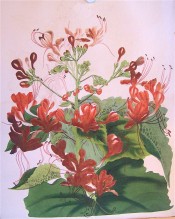Clerodendrum speciosissimum Paxt.
Frost tender, erect, open, evergreen shrub with opposite, heart-shaped, corrugated, toothed leaves to 30cm long, and terminal panicles of salverform, bright scarlet flowers in summer and autumn. To 4m. [RHSE]. Some authors consider Clerodendron speciosissimum Paxt. to be synonymous with C. squamatum Vahl. which see. Clerodendron fallax Lindl. is now regarded as a synonym of Clerodendron speciosissimum Paxt. which see. In the early Victorian era they were clearly regarded as separate species and treated as such in Johnson’s Dictionary.
Horticultural & Botanical History
Introduced to Britain in 1835. [JD]. ‘This is one of the finest plants we have had the good fortune to figure; it is far superior in beauty to any of the fine family to which it belongs. The colours are so brilliant that the representation here made falls considerably short of doing it justice; indeed it is beyond the reach of the artist to give a faithful likeness of its colours. Being a plant of easy culture, no collection, however small, ought to be without it. Messrs. Leucombe [sic], Pince, and Co., of the Exeter nursery, received the plant from Belgium last year; it flowered profusely in their Nursery in August and September.’ [MB p.217/1836]. BR sub f.19/1844.
A specimen of C. fallax grown in a pot in a hot house at Whalley House, near Manchester, was described as ‘a magnificent plant, 6 feet in height, 8 feet in diameter, and 24 feet in circumference’. [Gard. Chron. 1848].
History at Camden Park
Listed in the 1845, 1850 and 1857 catalogues as Clerodendrum speciosissimum [T.331/1845]. It was presumably lost some time after 1845 as it was requested from Kew Gardens on 1st February, 1849. [MP A2933-1, p.165]. It was obtained from Kew Gardens as Clerodendrum fallax, brought out from England by Captain P. P. King in 1849. Macarthur indicates that it was ‘common before or long introduced’. [ML A1980-3]. It may also have been obtained from the London Horticultural Society as it was included among desiderata in a letter to John Lindley in a letter dated 15th February 1848 and marked ‘arrived’ on Macarthur’s copy [MP A2933-1, p.157], although this may refer to the Kew import. It was also requested of Loddiges’ on 13th February, 1848. [MP A2933-1, p.172].
Notes
Also known as Clerodendron.
Clerodendrum speciosissimum Hort.Angl. ex Schauer. (1847) = Clerodendron glandulosum Lindl.
Clerodendrum speciosissimum Van Geert ex Morr. = Clerodendrum speciosissimum Paxt.
Published Feb 22, 2009 - 02:43 PM | Last updated Feb 15, 2010 - 03:31 PM
| Family | Verbenaceae |
|---|---|
| Category | |
| Region of origin | Java |
| Synonyms |
|
| Common Name | Glorybower, Java glorybean |
| Name in the Camden Park Record |
Clerodendrum speciosissimum Clerodendrum fallax |
| Confidence level | high |


